Fire over the Horizon
Wildfires, defiance, and dismissal. Road trips through the reminders that we live in a changing world. August 17, 2018.
Thousands of yellow sunflowers lined the ground in untidy rows as far as sight could see through the haze. I squinted in their direction. They seemed to beam back. Above, the red orb of our sun did its best to light the world through a thick wall of wildfire smoke. Not much light got through, and the light that did softly brushed the world in a sooty tinge of orange, red, and gray. I imagined the end of the world looking something like the scene before me. The sunflowers worsened a creeping feeling of dread, preternatural imagery — the vibrancy of life backdropped by the exhaust fumes of death — evoking a discomfort in my existence. Entranced, I stood on road's edge, camera in hand. Ash fell from the sky and stuck to my car.
A disapproving blast of horn from a passing truck averted my focus and brought it back to my surroundings. I had been heading south on I-5 near Williams, California when I drove into a dark cloud of smoke emanating from the nearby County Fire, a massive wildfire which would end up burning 90,288 acres in the Yolo and Napa counties before being fully contained — an area roughly three times the land area of San Francisco. After leaving the field of sunflowers I sought out the fire itself. The earlier sense of dread followed me as I left the highway behind and drove toward the hills and source of the smoke.
I never saw flames, but I saw their impact: evacuations, emergency vehicles, road closures. The urgency could be felt, contrasting the dreadful calm of the sunflowers. Here, people knew they were under threat. Did the sunflowers know they beamed radiantly in the presence of destruction? The farmer who sowed the rows of these spirited flowers — what would they think of the sight? My mind leapt back and forth between the hills and the field, the hills and the field. I drove away from the activity and stayed out of the way.
For the rest of the drive home I thought about those sunflowers. Time and motion stripped the ash off my car. Life returned to normal, but my next road trip would take me into the smoke once more.
Three weeks later, I planned a last-minute camping trip to visit the June Lake area of the Eastern Sierra. June Lake nestles up against the mountains just a few miles south from where the west-east Highway 120 terminates at the north-south Highway 395. Both are world class scenic drives. Highway 120 climbs up into and over the Sierra through Yosemite National Park. Highway 395 runs through a high desert valley situated between the White, Inyo, and Sierra mountain ranges. Any itinerary touching these highways is a solid choice for the drive alone. I booked the last campsite at a campground near the lake and set out on Friday afternoon, hoping to make camp by midnight.
Driving anywhere in California serves as a reminder: the size and population of the state can make even weekend driving an epic affair. After hours spent in gridlock leaving the Bay Area, I reached an open stretch of highway near Manteca, a Central California town located about one hundred miles west of Yosemite’s border. With a clear view toward the Sierra mountains, now I could see: wildfire smoke poured from the mountain range, seemingly out of Yosemite itself.
At the next stop, I checked the road status for the park. Yosemite Valley had been closed to traffic due to threat from a wildfire named the Ferguson Fire, but Highway 120 remained open. The closure of the Valley — even temporary as described — worried me. I continued on.
A thick haze hung in the air along the highway through Yosemite. Signs of the fire management effort dotted the road. Fire engines refuelled at the few gas stations, empty flatbed trailers used to transport heavy forestry equipment occupied any turnout wide enough, and teams of firefighters congregated in cordoned-off parking lots. One firefighter watched me from the edge of the road as I drove by, flat facial expression wondering why are you driving through here? Urgency hung in the air and mixed with the haze.
Densely packed rows of red fir and lodgepole pine passed by in a blur. Soon, the road climbed up into a dreamlike scene of subalpine forests and meadows. Nearly bare, massive protrusions of glacially polished granite frequently interrupted the otherwise organically rich landscape. Olmsted Point — a viewpoint I consider a required stop — sits atop one of these protrusions at an elevation of 8,300’ and has an exceptional, unorthodox view of the famous Half Dome. When I reached the viewpoint, I pulled off and parked. The sun was in the middle of setting. Half Dome’s details barely made it through the haze. It looked pretty. Painted pink by the sunset.
My favorite part of the drive comes after leaving Yosemite’s eastern entrance: Tioga Pass. Whenever I see the pass, I wonder about the crazy people who decided to carve a road along the sheer gradients of stupifyingly prominent, eroded Sierra giants. One section of road sits at 8,640’ below an 11,240’-high peak, summit and asphalt separated by a bit over a half mile of horizontal distance. I wonder about the engineers who designed the road and the workers who built it. It is a marvel, and it is captivatingly beautiful.
On this night, a full moon softly lit the pass in reds and pinks, hue shifted by smoke. Taillights and headlights of traveling vehicles meandered along the road.
The rest of the drive from Tioga Pass to my campsite at Oh Ridge drew worry. The moon lit the way, but even so, visibility did not reach far through the smoke. I considered other plans. The air quality was miserable, maybe even sickening. I chose to see what the morning would bring and set up my tent — a change in wind could wisk my concern away. Alarm set to 4:30 AM, I fell asleep tucked into my sleeping bag, nostrils congested from a reaction to breathing the dirty air.
Unzipping the door to my tent, I poked my head outside and looked around. The moon still shone, sitting just above the mountains to the southwest. The air had cleared significantly, revealing details of the surrounding hills and peaks. Hints of haze and reddish hues lingered. I gathered my camera gear and left camp for June Lake. Its north beach was only a few minutes’ drive away.
The lakeshore drew no crowds with the sun over an hour from breaching the peaks of the White Mountains to the east. A family of geese kept me company, breaking the thick silence with the occasional honking fit. The water of the lake, perfectly still, reflected all above the water line. My camera clicked, snapped, and hummed as it captured the visuals of the early morning silence.
The sun rose. I found coffee and a place to read in town at a charming cafe called The Lift. The town awoke and joined me.
The sun rose higher. I swung off a rope swing into the cold waters of Gull Lake. The fishermen and paddleboarders and vacationers gathered on the beaches and in the waters.
The temperature climbed. I drove for dozens of miles on dirt roads through the Sierra foothills and hammocked in a remote grove of pine trees. Hikers on their way to distant trailheads passed by in high clearance vehicles.
The light of the day grew longer. I found a marooned section of wooden fence and marked the location on my phone, intending to return for a sunset photo shoot. Chipmunks, oddly abundant, scattered from the road as I drove back to camp to wait for the long summer sun to make its way back to the horizon.
I waited. Temperatures climbed to over 80 degrees at an elevation of 7.400’. Incredibly hot — worse yet, my campsite provided no shade. The discomfort did not feel out of the ordinary. Heat waves, droughts, and dry spells had become normal. We were conditioned to the extreme weather.
As I cooked dinner, a pair of deer wandered past my tent. I wondered what they thought of the heat, the dryness, the haze. Did they know fire burned just over the horizon? They seemed oblivious or perhaps dismissive, carrying about their business — like us. Conditioned to a new normal.
The smoke had crept back into the valley during my wait. I returned to the broken wooden fence next to the dirt road, camera in hand. The smoke enshrouded the mountains and blocked the soft light of magic hour. Surrendering to the low visibility, I drove back to camp; the camera would not hum on this evening. Darkness fell on the way. Campfires, well contained in metal rings, burned throughout Oh Ridge. I lit one myself. Irony not lost.
At the end of the night, anxious and determined to not be a part of the problem, I poured nearly four liters of water into the ring before retiring to my tent. My nose was still congested. It was hot. Sleep came slowly.
The pre-sunrise alarm blared. The tent door zipped open. The survey concluded: the smoke did not travel overnight and hovered thicker than I had yet seen. I fell back asleep and awoke after sunrise to take down my camp.
The scene of a packed-up camp is bittersweet. The work of taking everything down, putting everything away, cleaning everything up — it’s done. But it means you’re departing, leaving good times, and heading back to the quotidian of everyday life and the busyness of a more populated place. I took a moment to admire the arrangement of gear in the back of my car — not a cubic foot put to waste — before closing the hatch. One quick stop for coffee at The Lift and I set off toward home.
Winding mountain roads, encroaching guardrailless on the edges of sheer cliffs, captured most of my attention. The haze of wildfire smoke, from the nearby Ferguson Fire, draped over the park in thick patches. The fire had grown to a size of 51,000 acres.
The National Park Service would soon announce the indefinite closure of Yosemite Valley as well as parts of Highway 120 at the height of National Park season. Evacuation orders were issued and carried out. Two weeks after my drive through the park, the fire’s acreage toll would reach 95,000. I later read that the Ferguson Fire was one of 17 large fires actively burning in California. During the hottest month on record. With peak fire season yet to come.
As I neared Yosemite’s Big Oak Flat Entrance, the smoke let up a little, revealing details in the surrounding forest. Blackened trunks of pine stretched skyward in a wide area along the road. The trees bore no leaves, taken by fire or fallen after the trees stopped living. Forest devastation areas often bear Pompeii-like scenes; the trees stand in death as they lived in life, frozen in place until disturbed by wind, or gravity, or man. Later, at home researching the devastation, I discovered the cause as the 2013 Rim Fire, the fourth largest wildfire in California history at 257,314 acres according to online articles. But the information was already outdated. The Rim Fire had been pushed down in rank to fifth by the Mendocino Complex Fire, which topped the list of California’s 17 active fires and recently titled the largest fire in state history at over 366,000 acres. Imagining the scene of desolation before me as an expanse of hundreds of square miles betrayed my sense of reality. It just didn’t seem possible.
Driving past rows of dead trees, I spotted a patch of green high in the air, a set of living branches isolated and alone sitting atop an otherwise-blackened tree. The sight of the color awoke my eyes to more; the forest floor had begun to restore itself, a lush undergrowth swelling up to surround masts of scorched trees. Signalling defiance, the lone patch of leaf-adorned branches spread out like a sail in the wind. The vibrancy of life flaunted itself in the face of death, in the face of a warming environment, refusing to concede to the new normal.
Fire kills, yes, but it serves a restorative function in nature — part of a natural cycle. Humans do not share in the cycle. We must intervene when our existence is threatened, and our existence depends on an optimal habitat, a narrow band in the expansive spectrum of conditions our planet has supported since its formation. The green of the fire desolation zone reminds us: the Earth will survive swings in its habitability. We don't need to save it, we need to save ourselves.
I eventually reached home, rejoining the millions living in the Bay Area. The smoke followed me. The haze, the red orb, the sense of dread, the contrast of life backdropped by signs of death — they returned at sunrise and sunset each day for over a week. The sight at first gave us pause. It soon became normal, and we continued on with our lives.
Donate to the Wildland Firefighter Association, Firefighters Charitable Foundation, or Direct Relief to support firefighting and relief efforts for communities threatened by wildfires in California.
Donate to The Sierra Club Foundation or the Environmental Defense Fund to support environmental research and advocacy. Shameless plug: 10% of proceeds from my store go to The Sierra Club.
Sign up for my newsletter to get notified when I publish stories like this.







